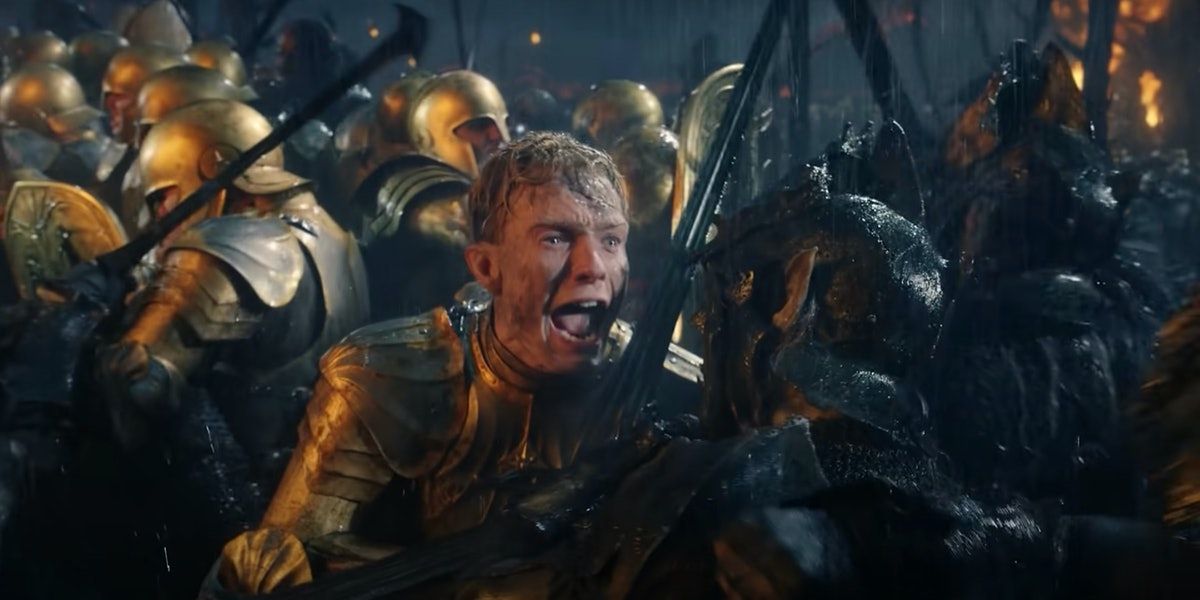Editor's note: The below contains spoilers for Episode 2 of The Rings of Power.
In the second episode of The Lord of the Rings: The Rings of Power, Elrond (Robert Aramayo) visits the workshop of Celebrimbor (Charles Edwards), where he finds the hammer of Fëanor. The two characters discuss the tool, revealing to the public that with that hammer, Fëanor forged the Silmarils, jewels that would bring great pain to Middle-earth. These jewels were also stolen by Morgoth, the first Dark Lord, who almost turned away from his evil crusade after spending weeks admiring the Silmarils' beauty.
While the scene is a treat for fans of J.R.R. Tolkien’s literary work, it might confuse viewers who only followed Peter Jackson’s The Lord of the Rings trilogy. So, to give you a proper background on the First Age of Middle-earth, let’s discuss the Silmarils and how they are connected to Arda’s history.
What Are the Silmarils?
The Silmarils were created by an Elf-lord named Fëanor at a time where Elves lived in Valinor, the land of the Valar. In Tolkien’s cosmology, the Valar were divinities sent by the One God to fill the Void with existence, birthing the world of Arda. While the Elves lived in Valinor, they profited from a peace that seemed to be eternal and poured their energies into mastery of every craft with the help of the Gods. Among the Elves, few were as dedicated as Fëanor, who became a smith so skilled that he forged three jewels from a mysterious material that not even the Valar knew where it came from. These jewels captured the light of the Trees of Valinor, the main source of light in Arda before the Sun and the Moon were created. And for that, the Silmarils became the most valuable — and the most coveted — objects in all Arda.
The substance Fëanor used to create the Silmarils was so resistant that no weapon in Arda could even scratch their surface, and only the most powerful of the Valar would ever be able to break them. On top of that, Varda, Queen of the Valar, blessed the gems so that no evil hands could ever touch the Silmarils without being hurt. Unfortunately, their indisputable value planted the seed of mistrust in Fëanor’s heart, who began to let greed create barriers between himself and his kin. The Silmarils also draw the attention of Melkor, who would soon be known as Morgoth, the first Dark Enemy of all life.
Why Are the Silmarils Important for Middle-earth?
Enticed by the Silmarils, Morgoth attacked Valinor after joining forces with Ungoliant, a being born from Darkness who took the shape of a giant black spider. Together, Morgoth and Ungoliant destroyed the Trees of Valinor, killed Fëanor’s father, and stole the Silmarils, fleeing to Middle-earth after their evil deed was done. Enraged by the events and convinced that even the Valar were his enemy, Fëanor takes an oath with his seven sons to wage war against anyone who tries to possess the Silmarils. Fëanor’s oath would set the course of Arda’s First Age, a period of time marked by war and destruction.
In the name of the Silmarils, Fëanor led an Elven army across the ocean to Middle-earth, a move that ultimately brought misery to multiple kingdoms of Elves, Men, and Dwarves. The many battles that followed Morgoth’s treason and vow are known as the Wars of Beleriand, or the Wars of the Jewels. So, it’s fair to say that the Silmarils defined the destiny of Middle-Earth for many centuries, and even many Ages. After all, Sauron, the enemy who rose in the Second Age and almost conquered the continent during the Third Age, was a general for Morgoth.
During the Wars of Beleriand, the Silmarils changed hands a few times until they were completely removed from the world. The first Silmaril was stolen from Morgoth by Beren, a human hero who happens to be the grandfather of Elrond Half-elven, a child that also descendent of the Elf-maiden Lúthien. The stone would remain with Beren’s family until it got to the hand of Eärendil, the husband of Beren’s granddaughter Elwing. Eärendil was the first mortal ever to set foot in Valinor, taking the Silmaril as a sign of respect for the Valar. The hero's pleas to the Valar led to the end of the Wars of Beleriand, as the armies of Valinor crossed the ocean and went to fight Morgoth in Middle-earth. For his bravery, the Valar sent this Silmaril to the sky to become The Star of Eärendil.
The other two Silmaril remained with Morgoth until the end of the Wars of Beleriand. Once the Dark Enemy had fallen, the Valar intended to recover the lost gems. However, two sons of Fëanor who were still alive, Maedhros and Maglor, decided to honor their oath and stole the Silmarils. By then, the Fëanor lineage had already committed multiple atrocities to get to the Silmarils and was no longer worthy of holding the gems. So, when Maedhros and Maglor got their hands on the Silmarils, the jewels burned them and caused immeasurable pain. To get rid of his torment, Maglor cast his Silmaril into the ocean, and there it lies, forever lost in the depths of the sea. As for Maedhros, he threw himself into a fiery pit with his Silmaril. One Silmaril to the sky, another to the seas, and the last one to the earth.
In the end, the three Silmarils became forever inaccessible for the people of Middle-earth and could no longer be the cause of any war. Of course, Sauron would soon forge the One Ring and other Rings of Power, bringing more dangerous jewels into existence and condemning Middle-earth to more bloodshed. Even so, by the time of The Lord of the Rings: The Rings of Power, the Silmarils are still remembered as legendary items that shaped history, and it’s nice to see the series diving deep into Tolkien’s lore.
The first two episodes of The Lord of the Rings: The Rings of Power are streaming now on Prime Video. New episodes become available every Friday.



